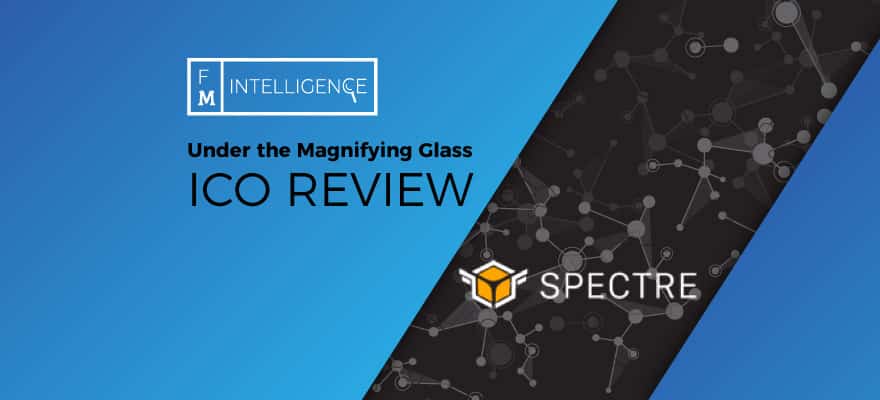The ICO rush is upon us, with dozens of new initiatives popping up every day. And while some ICOs will be the next big thing, some are doomed to fail from the get go – telling who’s who is no easy task. This article is a part of a series of reviews created by the Finance Magnates Intelligence Department as a public service.
Introduction
SPECTRE (speculative tokenized trading exchange), is a financial prediction market platform backed by a tokenized liquidity pool, according to its official website. The main purpose of the project is to take brokers out of the trading equation, providing an investment platform and autonomous, decentralized pool of liquidity owned by the ICO investors.
The founders of SPECTRE are sure that their ideas will be able to offer a higher level of transparency and revolutionize the way we look at the trading world.
- Category – Decentralized trading platform
- ICO Date – 11.17.2017-10.12.2017
- Phases – Stage I - Q4 2016/Q1 2017 Stage II - Q2 2017 Stage III - Q2/Q3 2018 Stage IV - Q1/Q2 2019
- Total supply – 480 million SPEC (50% token sale, 10% legal and advisory, 15% management, 5% bounties, 20% M&A reserve)
- Maximum raise – $10 million
- Available Payments – ETH
- Founded – Q4 2016, UK
- Blockchain platform – Ethereum
- Token standard – ERC20
- Regulation – British Virgin Islands (BVI) to conduct the ICO and perform SPECTRE operations
- Website – https://spectre.ai
Team
The core of SPECTRE’s team consists of ten people, and the key roles are played by executives of Neuchâtel - a technology company focusing on financial and blockchain technology.
Karan Khemani (CEO) - responsible for overseeing the design, architecture and expansion of SPECTRE into the market. He is a co-founder of Neuchâtel and FIIT, the companies behind SPECTRE, and an avid blockchain enthusiast.
Zisis Skouloudis (COO) - responsible for financial forecasting and risk management in SPECTRE's liquidity pool. Previously connected with INO SA and Siemens, designing and implementing their EPR software.
Elana Drakos (CFO) - responsible for SPECTRE's accounting, financial planning and analysis functions. Elena is a member of the ICAEW and an associate chartered accountant (ACA). Previously connected with KPMG.
Jai Sankar (CTO) – responsible for overseeing SPECTRE’s long-term technology vision and all important technical levels of the company structure. Connected with Neuchâtel, previously working for Credo Infotech, Mindtree, INSZoom and Hexaware Technologies.
Technology and features
Technological solutions proposed by SPECTRE were designed to disrupt the binary options and FX/CFD trading industries, empowering traders and lowering the possibility of fraud resulting from the unfair activities of brokerages. To achieve this, SPECTRE provides a broker-less financial trading platform connected to a decentralized liquidity pool, which is capitalized and owned by initial coin offering investors. Traders wanting to use the platform open a crypto-wallet which ensures that funds cannot by handled by SPECTRE employees.
In the case of trader losses, 96% of the traded amount expands SPECTRE’s liquidity pool, 2% is paid to SPECTRE’s dividend-token holders and another 2% covers fees and other costs. When a trader wins, he receives 75% ROI taken from SPECTRE’s liquidity pool.
SPECTRE states that due to these solutions and the decentralized nature of the project, the company will be able to offer retail traders 1-5% higher trade payouts, wider asset classes (including exotic instruments and trade types) and a special educational center.
Review
By analyzing SPECTRE’s whitepaper, you quickly realize that the company wants to offer retail traders a more secure form of binary options trading (based on blockchain technology), and stable profit (along with dividends) to ICO investors, due to the low performance of the binary options market players.
The dividend-token holder's earnings in this scenario are dependent on the average profitability of traders, which according to SPECTRE does not surpass 50% (for inexperienced traders). And when it comes to the utility token, its stable growth should be guaranteed by a planned coin-buyback-program (3% of the collected fees will be used to re-purchase the tokens from the market).
However, while the project offers a few important advantages like decentralization of the brokerage business, generation of the fees based on the volumes (not client losses) and no deposit requirement by the traders, we also need to identify potential problems which may disturb the business model. An undersubscribed ICO will result in generating a small balance sheet and in effect cap trades, slowing the liquidity pool growth. What's more, potential increases of the average win ratio of traders (above 57%) could deplete liquidity and force protective action to protect the project balance sheet. However, given the profitability of the average binary options trader, this scenario seems unlikely.
Verdict
SPECTRE's financial model assumes that by the end of 2020 the dividend paid per token will equal $0.31, and above $5 in the next ten years. The project itself looks really promising, however the uncertainty surrounding the 'traditional' binary options industry carries the risk of failure.
- Team – 4.5/5
- Legal – 3.5/5
- White paper – 4/5
- Partners – 4/5
- Financial Model – 4.5/5
- Overall – 4.1
In conclusion, the attempt to create a decentralized broker-less platform is a technological curiosity worthy of the interest of the industry. Issuing the utility- and dividend-tokens gives ICO investors the ability to choose the model that most suits their needs.

















